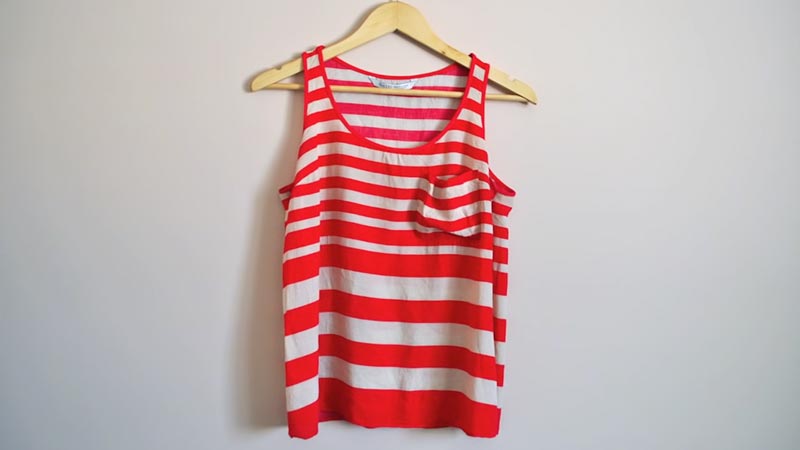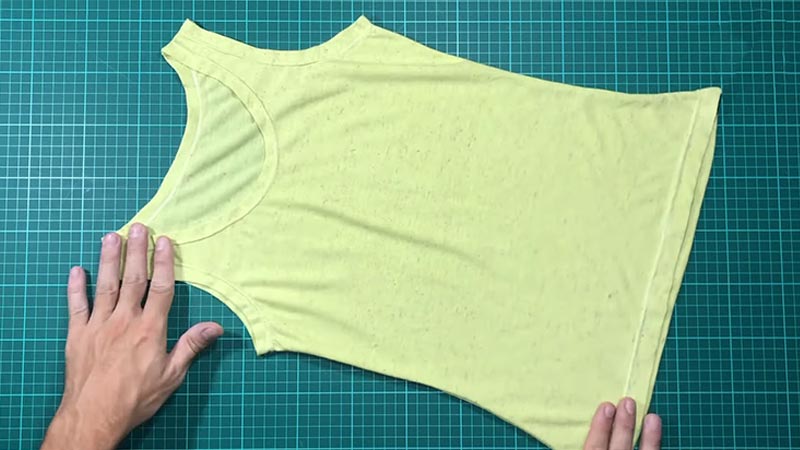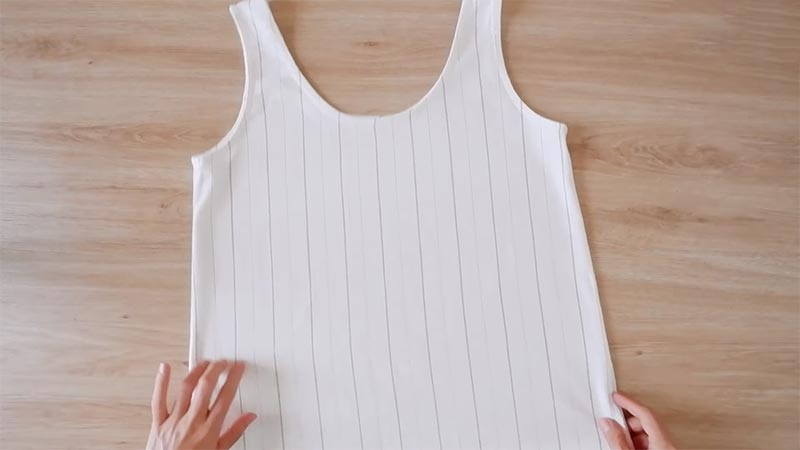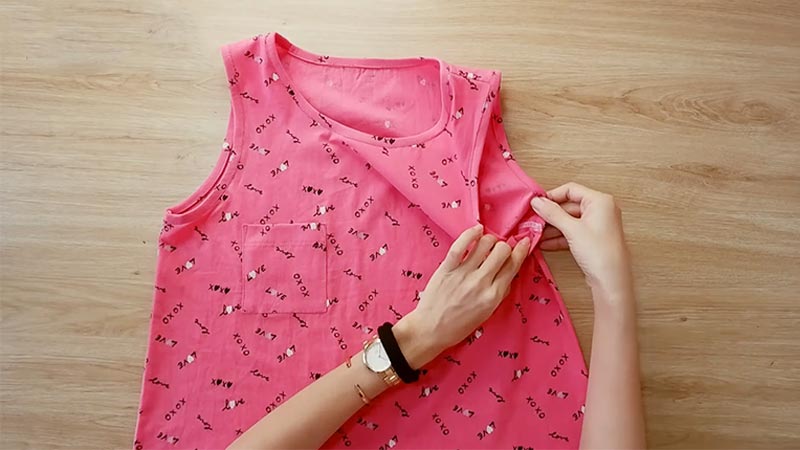Transforming a tank top into a personalized fashion statement doesn’t require advanced sewing skills or a closet full of expensive equipment.
With some basic tools, a dash of creativity, and a bit of patience, you can easily alter a tank top to fit your style and body perfectly.
Whether it’s tweaking the fit, adding embellishments, or reimagining its length, this DIY project not only breathes new life into old garments but also contributes to a sustainable approach to fashion.
This guide will walk you through the simple steps and offer tips to ensure your tank top alteration project succeeds.

What Is a Tank Top?
A tank top, also known as a sleeveless shirt or singlet, is a type of garment characterized by its lack of sleeves and typically low-cut neckline. It is designed to cover the torso while exposing the arms and shoulders.
Tank tops are usually made from lightweight, breathable fabrics like cotton, jersey, or blends. They are popular casual wear in warm weather, favored for their comfort and versatility.
Tank tops come in various styles, including racerback, spaghetti strap, and muscle tee, and are commonly worn for athletic activities and in casual and informal settings. They can be worn alone or layered under other clothing.
How to Alter a Tank Top Easily?
Altering a tank top can be a simple and cost-effective way to transform an old or ill-fitting garment into a stylish, personalized piece of clothing. Whether you want to make it shorter or tighter or add creative embellishments.
Here’s a step-by-step guide on how to easily alter a tank top:
Materials You’ll Need:
- Tank top to alter
- Sewing machine or needle and thread
- Pins
- Fabric scissors
- Measuring tape
- Chalk or fabric marker
- Embellishments
Assess the Fit
Before making any alterations, deciding what changes you’d like to make is essential. Consider the overall fit of the tank top – do you want it to be tighter around the waist or bust? Are the straps too long or short?
Try the tank top on and use a mirror to evaluate how it currently fits. If you plan to shorten it, consider the ideal length that complements your body shape and personal style.
Shortening the Tank Top
When you’re ready to shorten the tank top, remember to measure and mark twice before cutting. Use a measuring tape to ensure an even cut if you want the length to be the same all the way around.
When you’re going for a cropped look, consider marking the desired length while wearing the tank top. Take your time with the cutting to ensure a clean and even edge.
Adjusting the Fit
Consider how much you want to take in when pinching and pinning to adjust the fit. It’s often a good idea to start with a conservative adjustment and try on the tank top again. You can always take in more if needed.
Pay attention to how the fabric drapes and make sure it’s comfortable to move in. This step requires patience and a keen eye for detail.
Sew the Seams
When you’re using a sewing machine, practice on a scrap piece of fabric before sewing the tank top. Take your time and go slowly, especially around curves or areas where the fabric piles up.
Use small, even stitches for a secure seam when you’re hand-sewing. Remember to secure the ends of your seams with backstitching or knots.
Adjust the Straps
When you’re altering the straps, consider how much you need to adjust them. It’s often easier to make small adjustments at a time, as you can always trim more if needed.
You can easily change the length when the tank top has adjustable sliders. If not, be careful when sewing the straps in place to ensure they’re even.
Finish the Hem
When hemming, fold the fabric over twice to create a clean edge. Use an iron to press the fold in place before sewing to ensure a neat finish.
If you have a serger, you can use it to prevent fraying. Otherwise, a straight stitch along the edge will work well.
Add Embellishments
When adding embellishments, consider the overall aesthetic you want to achieve. Lay out the embellishments on the tank top before attaching them to understand how they’ll look.
When you’re sewing them on, use a thread that complements the color of the tank top. If you’re gluing, use a fabric-friendly adhesive and allow ample drying time.
Final Touches
Before considering the project complete, put the altered tank top back on for a final check. Pay attention to how it feels when you move and ensure you’re satisfied with the alterations. If any adjustments are needed, now is the time to make them.
Benefits of Altering Tank Tops

Altering tank tops can be a rewarding and practical way to breathe new life into your wardrobe.
Whether you’re looking to refresh your style, improve the fit, or repurpose an old garment, there are several benefits to altering tank tops.
Here, we’ll explore some of these advantages in detail:
Cost-Effective Wardrobe Upgrade
One of the most significant benefits of altering tank tops is cost-effectiveness. Rather than spending money on new clothes, you can make your existing tank tops feel like new with just a few simple adjustments.
This saves you money and reduces clothing waste, contributing to a more sustainable lifestyle.
Customized Fit
Everybody is unique, and off-the-rack clothing may not always fit perfectly. Altering tank tops allows you to customize the fit to your specific measurements and preferences.
You can make it as snug or loose as you like, ensuring comfort and confidence when wearing it.
Personalized Style
Altering tank tops provides an opportunity to express your personal style. You can experiment with different lengths, necklines, and strap styles to create a look that suits your taste.
Add embellishments, embroidery, or unique details to make your tank tops stand out and reflect your individuality.
Reviving Old Favorites
We all have those beloved tank tops that we’ve worn so often they’ve started to show signs of wear and tear. Instead of saying goodbye to these favorites, you can give them a second life by making necessary alterations.
This means you can continue to enjoy the comfort and sentimentality of your old tank tops while making them look fresh again.
Sustainability and Eco-Friendliness
By altering tank tops, you actively contribute to reducing the environmental impact of fast fashion. The fashion industry is a significant contributor to pollution and waste.
By extending the lifespan of your clothing through alterations, you help reduce the demand for new garments and decrease the overall carbon footprint.
Creativity and DIY Satisfaction
Altering tank tops is a creative endeavor that can be deeply satisfying. It allows you to exercise your creativity, experiment with different sewing techniques, and even upcycle other materials into your designs.
The sense of accomplishment and pride that comes from wearing a garment you’ve altered yourself is truly rewarding.
Perfect for Seasonal Changes
Tank tops are versatile pieces that can be worn throughout the year when properly altered. You can layer them under cardigans, jackets, or blazers for colder seasons.
By altering the fit or adding sleeves, you can adapt your tank tops to suit any weather, making them a practical addition to your wardrobe.
Learning New Skills
Working on tank tops can be an excellent way to develop your skills when you’re new to sewing or altering clothing.
It’s a relatively simple and forgiving project for beginners, and as you gain confidence, you can tackle more complex alterations and even work on other types of garments.
Common Mistakes to Avoid to Alter a Tank Top

When altering tank tops or any clothing, there are some common mistakes to watch out for to ensure a successful outcome.
Here are some of these mistakes and tips on how to avoid them:
Uneven Seams
Symptom: The seams appear wavy, crooked, or uneven.
Solution:
- Use pins or clips to secure the fabric in place before sewing.
- Practice sewing in straight lines on a scrap piece of fabric before working on the tank top.
- Take your time and go slowly, especially around curves or areas where the fabric piles up.
Fraying Fabric Edges
Symptom: The edges of the fabric are starting to fray after cutting.
Solution:
- Finish the edges with a zigzag stitch on a sewing machine or use pinking shears to prevent fraying.
- Consider using a serger if you have one, as it provides a clean finish to fabric edges.
Incorrect Fit
Symptom: The tank top still doesn’t fit properly after alterations.
Solution:
- Double-check your measurements and compare them to your altered garment. Adjust as necessary.
- Try the tank top multiple times during the alteration process to ensure you’re on the right track.
Thread Tension Issues
Symptom: The thread is too loose or tight, causing uneven stitches.
Solution:
- Check your sewing machine’s manual for instructions on adjusting thread tension.
- Do a test stitch on a scrap piece of fabric to ensure the tension is correct before sewing on the tank top.
Fabric Stretching or Distortion
Symptom: The fabric has stretched or distorted during the alteration process.
Solution:
- Use a stabilizer or interfacing to reinforce areas that may be prone to stretching.
- Be cautious when handling stretchy fabrics, and support the fabric as you sew to prevent distortion.
Difficulty Hemming
Symptom: The hem doesn’t lie flat or look uneven.
Solution:
- Press the fabric before hemming to ensure it lies flat and even.
- Consider using an iron-on hemming tape for a clean and easy finish.
Snags or Tears
Symptom: The fabric has been accidentally snagged or torn during the alteration.
Solution:
- If the tear is small, consider patching it with a piece of matching fabric.
- If the snag is along a seam, reinforce the area with extra stitches to prevent further damage.
Misaligned Embellishments
Symptom: Embellishments like lace, sequins, or patches are not evenly placed.
Solution:
- Lay out the embellishments on the tank top before attaching them to understand how they’ll look.
- Use a ruler or measuring tape to ensure that embellishments are evenly spaced and aligned.
Care Instructions and Maintenance

Proper care and maintenance are crucial to ensure that your altered tank tops stay in good condition and continue to look their best.
Here are some care instructions and maintenance tips to keep in mind:
Read and Follow Care Labels
Pay close attention to the care label on your tank top is important. These labels are designed to provide specific instructions based on the fabric type and any special treatments the garment may have undergone.
Whether it advises gentle hand washing or indicates that the fabric can handle machine washing, adhering to these instructions will help preserve the quality and lifespan of your tank top.
Hand Washing vs. Machine Washing
Hand washing is a gentle approach that is particularly beneficial for delicate fabrics or those with intricate embellishments.
Gently agitate the garment using a mild detergent and cold water, ensuring even coverage. Machine washing, on the other hand, should be done with care. Select a gentle cycle and use cold water to maintain the fabric’s integrity.
Placing the tank top in a laundry bag helps shield it from friction with other garments and prevents potential damage.
Drying
Opting for air drying is the safest method for preserving the shape and quality of your tank top. Lay it flat on a clean towel and carefully reshape it to its original dimensions.
Avoid direct sunlight or heat sources, as excessive heat can shrinkage and damage delicate fabrics.
Ironing
Following the care label’s ironing instructions is essential for maintaining the appearance of your tank top. If allowed, use a low heat setting on your iron.
Placing a pressing cloth or a clean cotton fabric between the iron and the tank top is a protective barrier, especially crucial for delicate fabrics or garments with embellishments. Glide the iron smoothly and avoid applying excessive pressure.
Avoid Excessive Sun Exposure
Prolonged exposure to direct sunlight can be detrimental to fabrics. It can lead to fading of colors and a weakening of the material. To safeguard your tank tops, it’s advisable to store them in a cool, dry area away from areas of prolonged sun exposure.
Proper Storage
It is recommended to Neatly fold your tank tops and store them in a clean, dry area.
Avoid hanging them for extended periods, as this can lead to stretching, especially if the fabric is particularly delicate or prone to sagging.
Handle Embellishments with Care
Handling it with extra care is crucial when your tank top features additional elements like sequins, beads, or lace.
Turning the garment inside out before washing can help protect these delicate details. Avoid vigorous rubbing or twisting, as this can lead to damage.
Address Stains Promptly
Accidents happen, and stains can occur. It’s essential to address them promptly. Blot the stain gently with a clean cloth, working from the outside to prevent spreading.
If necessary, treat it with a stain remover that is appropriate for the fabric type. Always follow the manufacturer’s instructions.
Regular Inspections
Periodically examining your tank tops for loose threads, snags, or signs of wear and tear allows you to catch any issues early. Addressing them promptly can prevent further damage and prolong the life of your garment.
Professional Cleaning for Delicate Fabrics
For tank tops made from delicate or special fabrics like silk or satin, seeking professional dry cleaning services is often the best approach.
Dry cleaners have the expertise and equipment to handle these fabrics with care, ensuring they are cleaned effectively without compromising their quality.
FAQs
Can I alter a tank top if I’m not experienced in sewing?
Yes, tank tops are relatively simple garments to alter, making them a great starting point for beginners.
What tools do I need for altering a tank top?
You’ll need basic sewing supplies like a sewing machine or needle and thread, fabric scissors, pins, measuring tape, and chalk or fabric markers for marking.
How can I adjust the fit of a loose tank top?
Turn the tank top inside out and use pins to pinch and secure the excess fabric along the sides. Then, sew along the pinned lines to create a snugger fit.
What’s the best way to shorten a tank top?
Measure and mark the desired length, then carefully cut along the marked line. Finish the new hem by folding and sewing it in place.
Can I add embellishments to my tank top after altering it?
Yes, after you’ve completed the basic alterations, you can get creative by adding embellishments like lace, sequins, or fabric patches.
Wrap Up
Altering a tank top is a versatile and accessible DIY project. You can transform an old or ill-fitting garment into a personalized fashion statement with basic sewing skills and a few essential tools.
Whether it’s adjusting the fit, shortening the length, or adding creative embellishments, the process is both cost-effective and environmentally friendly.
You can achieve professional-looking results by following careful steps and avoiding common mistakes.
This endeavor not only refreshes your wardrobe but also hones your sewing abilities. Embrace the creative possibilities and enjoy the satisfaction of wearing a tank top that’s uniquely tailored to your style and comfort.
Leave a Reply